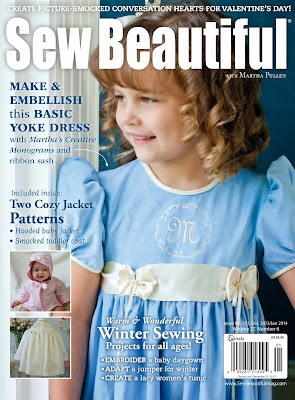Patterns - Chances are you have more than one bishop pattern. In addition to independent designer patterns, check smocking magazines and books. Not all bishops are created equal! Take time to compare patterns. Lay the front section of one pattern on top of the front of another. Note the differences in the arm curve at the top and side. Compare the width of each piece. Check the length. You may find what works for one look does not work for all the bishops you have in mind.
Fabric - Each pattern is designed for a specific weight of fabric. Many bishop pattern instruction sheets recommend using lightweight fabrics such as batiste. You may use the pattern as it is for the recommended fabric. However, if your pattern is designed for batiste, but you wish to use a heavier fabric, use a pattern that has reduced fullness or make adjustments to your pattern.
The following pictures show three bishops cut from the same pattern. The fabrics are Imperial batiste, Concord cotton calico and Spechler-Vogel corduroy. Each bias neckband is cut to the identical length. Note the batiste pleats are nicely spaced (photo 1A). The calico pleats are tightly packed, but still fit the neckband (photo 1B). However, the corduroy bishop does not fit the neckband at all (photo 1C).
Fibers - Fabric sometimes has a different appearance when it is pleated. Choosing fibers and colors after pleating is more efficient. Working a few stitches will help you make the final decision. Remember, three strands of embroidery floss are not the only option for smocking. Try two strands for a delicate look; try four strands for smocking a novelty print. Branch out! Try new fibers such as floche and stranded silk.
Smocking Plate - Bishop design plates are slightly different than straight yoke plates. For a bishop, look for a smocking design that uses stitches with less give at the top (neck) such as cable, stem and outline stitches. Stitches become progressively more open toward the lower rows of the design (shoulder). Lower rows are usually trellis stitches, possibly trellis/cable combinations. Straight yoke plates tend to have less giving stitches for the top and bottom rows.
The pattern dictates the number of rows of smocking. Look at the arm curve on the pattern. There is a straight portion from the top down, then it begins to curve. The portion you will smock is the straight section. Measure this straight section against your brand of pleater to determine the number of rows you can pleat on that size (photo 2). Remember to include holding rows. Not all bishop plates are suited for every size bishop. Most commercial plates for bishops are easily adjusted.
Change the number of rows on larger or smaller bishops by adding or eliminating a repeat of a row at the top or bottom of the design. When adjusting designs, take out the row least likely to affect the flair of the bishop at the shoulders.
Learn how to sew a beautiful bishop dress on the Ready-to-Smock - Smocked Bishop Construction DVD with Connie Palmer. You'll also discover valuable tricks as Connie reviews perfect neckbands, plackets, a variety of sleeve finishes and much more!
Sew On, Sew Well, Sew Beautiful,
Cyndi and Amelia














